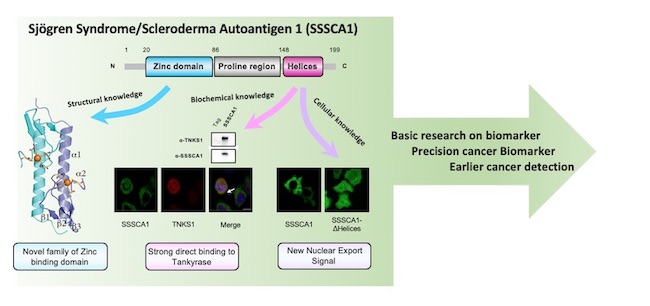The human protein known as 'Sjögren syndrome/scleroderma autoantigen 1' (or SSSCA1) received its name as it was found to be upregulated in a subset of patients suffering from conditions called Sjögren syndrome (an autoimmune disorder associated with dry eyes and mouth) and scleroderma (a group of rare diseases that involve the hardening and tightening of the skin and connective tissues).

SSSCA1 has also been highlighted as a potential biomarker in various cancer studies - i.e. a protein that can be used as a marker to help researchers and doctors understand what type of cancer a patient has, and/or how progressive the cancer is.
Despite its association with various human disorders, relatively little is known about the structure and function of SSSCA1. It is a small protein that is found in most cells of the human body, but a comprehensive understanding of how it functions within cells, including which other proteins it interacts with, has been lacking.
Collaborative project involving UK, Denmark, and Norway
In their new article, published in the open access journal Communications Biology, members of the Membrane Transport Group, led by J Preben Morth, collaborated with researchers in the UK, Denmark and Norway to investigate the structure of SSSCA1. This revealed a domain within the protein that has a dual function: 1) facilitating the binding to a protein called Tankyrase (with a role in telomere elongation*); and 2) containing a so-called 'nuclear export signal'. This signal is found on many cellular proteins, and acts to transport the protein from the nucleus after the cell has divided. This is the first time that a transport signal sequence has been shown to have a dual function.
An important biomarker for cancer
The results indicate that SSSCA1 may be an important biomarker for cancer with a direct link

to cell division. Furthermore, the signal sequence identified in this study can potentially be used to identify similar sequences with similar functions in other proteins.
The paper, Sjögren syndrome/scleroderma autoantigen 1 is a direct Tankyrase binding partner in cancer cells, Perdreau-Dahl et al, Communications Biology, can be read in full on the Nature website.
The work featured in the Communications Biology publication was completed at NCMM prior to the Membrane Transport Group rotating out of the centre in August 2019, after J Preben Morth accepted a permanent professorship at the Technical University of Denmark (DTU). Harmonie Perdreau-Dahl, first author on the paper, is currently a postdoc in the Louch Group, Institute for Experimental Medical Research, Oslo University Hospital.
*Tankyrase is a protein involved in the lengthening of a region of our chromosomes called telomeres, which become shorter with each round of cell division. Failure to regulate telomere lengthening properly can have severe consequences, and is linked to both cancer and cellular ageing.
